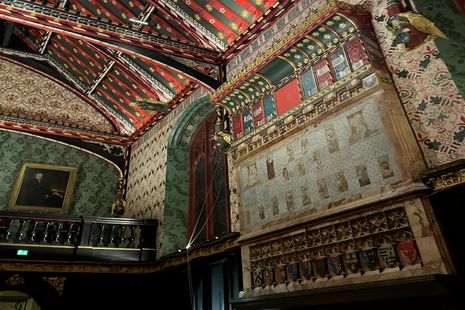William Morris’ little-known labours in Cambridge
Otto Bajwa-Greenwood argues that William Morris’ tiles at Queens’ are less well-known but just as enduring as his other works

In a world bent on quantitative measures of progression, there has been a tendency to denigrate the importance of creating beauty amid persistent industrial stresses. However, none perhaps rose to this challenge as well as the poet, designer, and polymath William Morris (1834-1896). Renowned as a major contributor to the revival of traditional British textiles and design techniques, who held connection to the pre-Raphaelites and heavily inspired the Arts and Crafts movement, Morris made a powerful case for art’s centrality in human existence. Crucially, he returned focus to the sweat, labour, and care of human hands.
Disillusioned with mechanised change in Victorian England, Morris founded the interior design company Morris, Marshall, Faulkner & Co. in 1861, looking to re-fashion a connection with the beauty of the natural world through maximalist, colourful patterns that could be democratically enjoyed by all. As Varsity’s Thea Redmill articulates in her argument for his radical accessibility, “Morris’ floral motifs were a statement against the industrialism of Victorian society.”
“Crucially, he returned of us to the sweat, labour, and care of human hands”
Lesser known, however, is the fact that Morris’ artistic influence stretched into Cambridge, specifically into Queens’ College. Morris was commissioned by the architect G.F. Bodley to decorate the elaborate chimney tiles in the Queens’ Old Hall. The chimneypiece, worked on over two separate occasions (1862-63 and 1875), acts as a powerful display of both Morris’ ability and also his artistic ethos. A rich alabaster, reminiscent of Morris’ daisy pattern wallpaper design, frames tiled portraits of Queens Margaret of Anjou and Elizabeth Woodville, the Foundresses. Underneath these portraits, comes a series of tiles depicting the labours of the months. These include a series of scenes displaying the working lives of both the aristocracy and the peasantry, moving from the toil of mowing (June) and reaping (July) to pressing grapes (September) and feeding pigs (October).
As Michaela Braesel’s history of the tiles at Queens’ elucidates, “[t]he scenes are set in a variety of different historical periods,” portraying the figures in “medieval costume,” clothing from the “Tudor or Stuart periods,” and also in “flowery dresses and laced bodices” that “seem to date from around the middle of the eighteenth century.” Morris’ symbolic rejection of “chronological consistency in favour of variety,” along with the emphasis he places upon showing working tasks, speaks to the universality of his approach. Without the alienating and impersonal influences of machinery anywhere to be seen, it is human labour working in unison within the cycles of the natural world that powerfully unites humanity.
“The tiles demonstrate the collaborative processes of progress, and they appeal to an innate drive for creativity through human effort”
That the tiles advocate for labour unity is quite possibly a product of its collaborative authorship. The patterns and designs come from the varied influences of Ford Madox Brown, Edward Burne-Jones, Dante Gabriel Rossetti, drawing inspiration from the medieval book of hours, the Palazzo Medici in Florence, Chartres Cathedral, along with coded references to the medieval Flemish artist Jan van Eyck. Their designs even include additional work finished by local craftsmen around the Cambridge area. For the successive generations of Cambridge students who dine in Queens’ Old Hall, these tiles act as a reminder of the human capacity for beauty through collective effort. The tiles demonstrate the collaborative processes of progress, and they appeal to an innate drive for creativity through human effort.
Although Morris has always been highly regarded in Oxford, being the site upon which his formative education was carried out, early collaborative pieces, and his later activism work in socialist circles, Morris’s hand in Cambridge should be greater emphasised. The importance he attributed towards the ideals of human effort and interconnection with the natural world feel particularly pertinent in an economic and social context in which ease and, thus disassociation, are increasingly becoming the norm. When looking upon Morris’s tiles, students should be reminded of the significance of challenging comfortable solutions, and be encouraged to dote on the value of their own personal, indeed very human, mark in the world in which it can readily be lost.
 Comment / Plastic pubs: the problem with Cambridge alehouses 5 January 2026
Comment / Plastic pubs: the problem with Cambridge alehouses 5 January 2026 News / New movement ‘Cambridge is Chopped’ launched to fight against hate crime7 January 2026
News / New movement ‘Cambridge is Chopped’ launched to fight against hate crime7 January 2026 News / Uni-linked firms rank among Cambridgeshire’s largest7 January 2026
News / Uni-linked firms rank among Cambridgeshire’s largest7 January 2026 News / SU stops offering student discounts8 January 2026
News / SU stops offering student discounts8 January 2026 News / Cambridge businesses concerned infrastructure delays will hurt growth5 January 2026
News / Cambridge businesses concerned infrastructure delays will hurt growth5 January 2026









